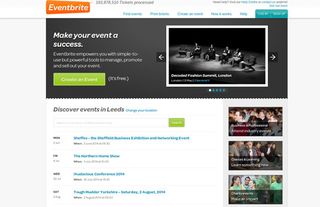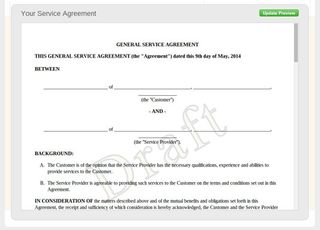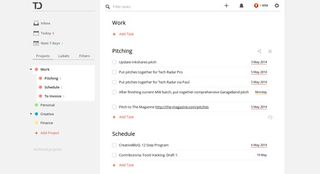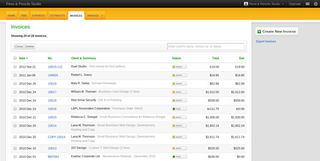The 12-step guide to success as a freelance designer
Want to leave your job and work for yourself as a freelance designer? Here's what you need to do.
We'd all like to leave our jobs and set off on our own. But without discipline and careful project management, you can end up overworked, underpaid and worse off than before.
So, here’s one of those things they didn't teach you at design school; there are a dozen stages to every freelance job you do - and the fun part, making things, is just one of them.
If you want to get consistent work, if you want to deliver on time and, most importantly, get paid, stick to this step-by-step workflow. It will minimise chaos and help you concentrate on making great designs that earn you enough money to become self-employed and boss-free.
01. Getting clients

As a freelancer or small business, you need clients and - as well as getting your work seen - that means building a network. Start by joining relevant groups on LinkedIn, sign up to job boards and freelancing sites.
But with all this online activity it’s easy to forget that the best contacts are made in the real world - so keep an eye out for business networking events in your area; coffee mornings for start-ups, Pecha Kucha evenings and so on. Try MeetUp and EventBrite to search for stuff happening near you.
02. Consultation
Sitting down for a conversation - physical or virtual - is an essential step when starting a project. A mistake that many rookie freelancers make is allowing clients to lead the process too much. This can be really bad for both of you. Talking things through helps you to avoid that. You know your practice and your business so it’s important to manage expectations as early as possible.
This is also the time to do any required negotiation; setting fees, your availability, a schedule for revisions and deadlines. If you skip this stage you may find that your client will dictate all of that for you, in terms that are favourable only to them.
Get the Creative Bloq Newsletter
Daily design news, reviews, how-tos and more, as picked by the editors.
Most importantly, you can build an understanding of your client’s needs. If you’re supplied with a brief by your client up front, go back to the client and use that as a guide for discussion, highlighting any areas you don’t understand.
03. Pitch
From consultation you can then formulate a pitch. A pitch can take several forms. It can be a physical presentation of your preliminary work or a detailed brief. Its enables you to show the client what you intend to do - and to get their agreement on that.
Your client will want to be involved creatively. It’s better to give them as much input at the pitch stage as possible, rather than in a few months time when you’ve produced work of finished quality.
04. Agreement

So far, everything has been formative. This is where things get serious. More established organisations will have a standard contract for outsourcing, but many won’t.
You don’t actually need a legally notarized contract, but you do need to have everything that you intend to do written down. A Letter of Agreement is a perfect mechanism for this. Make sure it details what work you intend to undertake (including amendments), the deadlines that you’ve agreed, fees for the work and, crucially, what you will charge for additional work added to the agreement.
If you don’t know where to start, try out free legal documents site LawDepot - with free templates for work contracts and service agreements you can amend, then reuse again and again.
05. Time management

Time management tools are your best protection against the agents of chaos. Online services like Todoist and ClickUp enable you to break down any project into a list of bite-size tasks. They’re also available as mobile apps.
There’s much to be recommended in these tools. Being able to tick off a task from your list gives you a feeling of progress - and keeps every project on track and on time.
06. Preparation
Prep will vary from practitioner to practitioner but we know one thing for certain; if you try to skip this stage you’ll fall on your face. Make sure that you have all the equipment and software you need to complete the task. Make sure all that equipment is working.
For some jobs you’ll need to prototype; create wireframes, sketches, storyboards, do research and so on. Ensure you have studio time booked, tickets sorted, meetings arranged - all in advance. Don’t skimp on this step - it’s tempting, but this is where you’ll find the holes in your boat before you set sail.
07. Creative
Here’s the bit you like to do - the part you trained to do. Notice that it’s only one step among many because, even though you may call yourself a designer or illustrator or web developer, this is only a small part of the job. Without mastering the other steps, you won’t be working in the industry for long. It’s also the tipping point. Every step after this should have been prepared for in the first six.
08. Delivery
Your consultation process should have enabled you to arrive at a realistic, mutually agreed deadline. Don’t miss it. You should also have decided exactly how to deliver the work too. All this should be detailed in your letter of agreement.
09. Review
This step is out of your hands, but you do need to be prepared for it and to expect it. That’s why there’s a consultation phase.
One of the frustrating things about any creative collaboration with corporate entities is that your clients will invariably want changes made. The criticism you receive may be constructive and you may find that it will help you to continue and refine your process with that client. Sometimes, it won’t be. Expect a Bernard or Brenda from marketing, with an A level in Art to be particularly insightful.
10. Revision
It’s important to make sure that you don’t get locked into a nightmare cycle of endless revision. One way to ensure that doesn’t happen is by specifying a limited number of revisions in your letter of agreement - and make sure that you get paid for any revisions or amendments beyond that point.
11. Book keeping

It’s funny that so many creative freelancers and businesses think of bookkeeping as the boring part... But you can’t make a living from creativity if you don’t invoice.
There are some free - or reasonably inexpensive - online services that can help you out with that. CurdBee is one of the most comprehensive and, at $5 a month, cost-effective entries. It includes features that enable you to track time on a job and export data to spreadsheet formats. There’s also MakeSomeTime, a prettier, simpler online invoicing tool.
If you and your clients are happy to use PayPal, business users can generate their own invoices on the platform, free.
One of our favourite new(ish) financial toys is SimpleTax. It’s an online system that you enter all your invoiced earnings and expenses into. At the end of the financial year it calculates your tax for you and you can file your return to the HMRC. Goodbye accountacy fees.
12. Payment
Finally all the hard work pays off and you get to spend the money on iPads and beer. Sometimes, though, clients prefer to keep your money in their bank account. Naughty clients.
Go all the way back to your letter of agreement again, first. You should agree a maximum payment period with your client upfront. Thirty days is standard in law.
If resubmitting your invoice doesn’t work, a letter restating your original terms should be sent. Make sure that it’s sent 'signed-for'. LawDepot may come in handy again - you can use the service to find a template for a sternly worded letter. Unlike emails and texts, you can prove a recorded letter has arrived.
Under UK late payment legislation you are entitled to add interest for every day past the agreed payment date. You can find a handy online calculator here.
Words: Karl Hodge

Thank you for reading 5 articles this month* Join now for unlimited access
Enjoy your first month for just £1 / $1 / €1
*Read 5 free articles per month without a subscription

Join now for unlimited access
Try first month for just £1 / $1 / €1
The Creative Bloq team is made up of a group of design fans, and has changed and evolved since Creative Bloq began back in 2012. The current website team consists of eight full-time members of staff: Editor Georgia Coggan, Deputy Editor Rosie Hilder, Ecommerce Editor Beren Neale, Senior News Editor Daniel Piper, Editor, Digital Art and 3D Ian Dean, Tech Reviews Editor Erlingur Einarsson and Ecommerce Writer Beth Nicholls and Staff Writer Natalie Fear, as well as a roster of freelancers from around the world. The 3D World and ImagineFX magazine teams also pitch in, ensuring that content from 3D World and ImagineFX is represented on Creative Bloq.
Related articles
-

-

-

-

